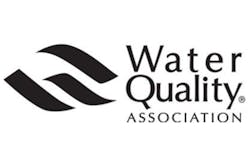Certification Action Line — Questions — May 2014
1. Removal of hardness, iron, manganese, hydrogen sulfide, harmful metal ions and organic compounds, and the control of corrosion and scaling in water all involve the transformation of substances in accordance with science of _______________.
a. Bacteriology
b. Chemistry
c. Limnology
d. Physics
2. A compound is a substance that cannot be decomposed into simpler substances by chemical reaction.
(True or False)
3. An atom or group of atoms, such as a molecule, that have an electric charge is called a/an:
a. Valence
b. Electron
c. Ion
d. Mixture
4. _______________ is a measure of freely moving ions in a solution and also of the total dissolved solids (TDS) of the solution.
5. Elements, ions and compounds entering into chemical combinations always do so in proportion to their:
a. Equivalent weight
b. Valence
c. Electrons
d. Atomic weight
6. Given the atomic weight of calcium (Ca) is 40.08, carbon (C) is 12.011 and oxygen (O) is 15.9994, what is the equivalent weight of the compound calcium carbonate (CaCO3)?
a. 100.089
b. 50.045
c. 25.023
d. 33.363
7. One pound of salt (NaCl) is chemically equivalent to how many grains of water hardness measured as CaCO3?
a. 8991
b. 3350
c. 3996
d. 5994
8. A one normal (1N) solution of calcium carbonate would be prepared by adding _______________ grams of CaCO3 to deionized or distilled water to make a one _______________ solution.
9. What chemical reaction takes place in treatment of water with potassium permanganate?
10. One milligram per liter equals how many pounds per million gallons?
